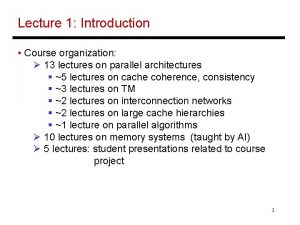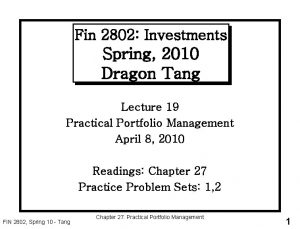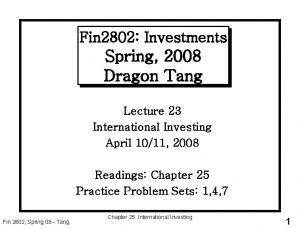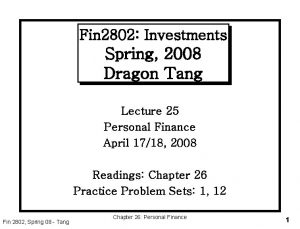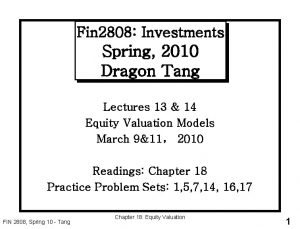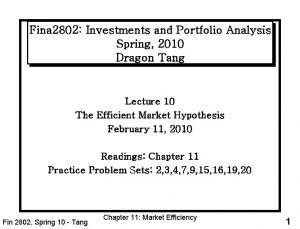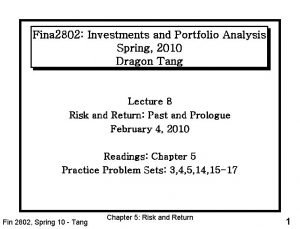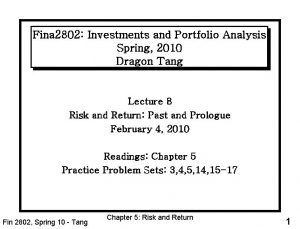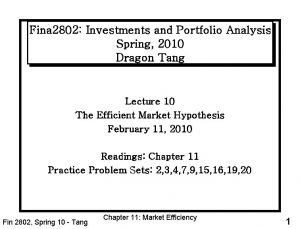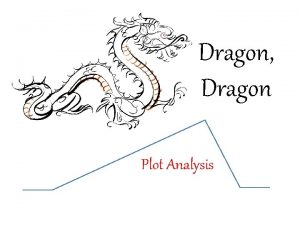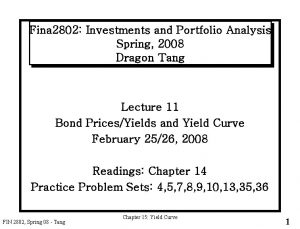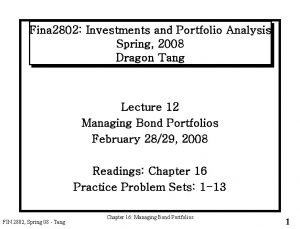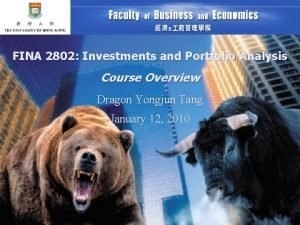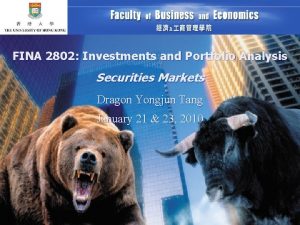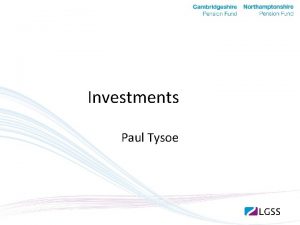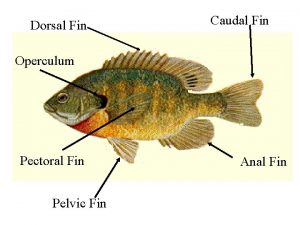Fin 2802 Investments Spring 2010 Dragon Tang Lectures








































- Slides: 40

Fin 2802: Investments Spring, 2010 Dragon Tang Lectures 21&22 Performance Evaluation April 13 & 15, 2010 Readings: Chapter 24 Practice Problem Sets: 4, 6, 8, 9, 10 -14 Fin 2802, Spring 10 - Tang Chapter 24: Performance Evaluation 1

Wall Street Interview Question You have a large jar containing 999 fair pennies and one two-headed penny. Suppose you pick one coin out of the jar and flip it 10 times and get all heads. What is the probability that the coin you chose is the two-headed one? Fin 2802, Spring 10 - Tang Chapter 24: Performance Evaluation 2

Performance Evaluation Objectives: 1. Compute risk-adjusted rates of return. 2. Decompose excess returns into components attributable to asset allocation choices versus security selection choices. 3. Assess the performance of portfolio managers. 4. Assess the value of Market Timing Ability Fin 2802, Spring 10 - Tang Chapter 24: Performance Evaluation 3

Performance • Skill – Timing ability (asset allocation) – Selection ability (security selection) • Luck Goal of performance evaluation is to distinguish skill (and specific components) from luck! Fin 2802, Spring 10 - Tang Chapter 24: Performance Evaluation 4

Risk-Adjusted Returns Comparison groups: • Blindly comparing rates of return ignores risk • Comparison groups with similar investment styles and portfolio characteristics can be used for performance comparison Fin 2802, Spring 10 - Tang Chapter 24: Performance Evaluation 5

Figure 24. 1 Universe Comparison Fin 2802, Spring 10 - Tang Chapter 24: Performance Evaluation 6

Risk Adjustments • Sharpe measure • Treynor measure • Jensen measure Fin 2802, Spring 10 - Tang Chapter 24: Performance Evaluation 7

Sharpe Method Reward-to-volatility ratio: _ _ Appropriate for measuring the relative performance of an entire portfolio. Fin 2802, Spring 10 - Tang Chapter 24: Performance Evaluation 8

M 2 Measure • Developed by Modigliani and Modigliani • Equates the volatility of the managed portfolio with the market by creating a hypothetical portfolio made up of Tbills and the managed portfolio • If the risk is lower than the market, leverage is used and the hypothetical portfolio is compared to the market Fin 2802, Spring 10 - Tang Chapter 24: Performance Evaluation 9

Figure 24. 2 M 2 of Portfolio P Fin 2802, Spring 10 - Tang Chapter 24: Performance Evaluation 10

M 2 Measure: Example Managed Portfolio: return = 35% standard deviation = 42% Market Portfolio: return = 28% T-bill return = 6% standard deviation = 30% Hypothetical Portfolio: 30/42 =. 714 in P (1 -. 714) or. 286 in T-bills (. 714) (. 35) + (. 286) (. 06) = 26. 7% Since this return is less than the market, the managed portfolio underperformed Fin 2802, Spring 10 - Tang Chapter 24: Performance Evaluation 11

Treynor Measure Excess return to beta ratio: _ _ Appropriate for measuring the relative performance of parts of a portfolio. Fin 2802, Spring 10 - Tang Chapter 24: Performance Evaluation 12

Jensen Measure Alpha of an investment (from CAPM): Appropriate for measuring the absolute performance of a portfolio. Fin 2802, Spring 10 - Tang Chapter 24: Performance Evaluation 13

Information Ratio = ap / s(ep) Information Ratio divides the alpha of the portfolio by the nonsystematic risk Nonsystematic risk could, in theory, be eliminated by diversification Fin 2802, Spring 10 - Tang Chapter 24: Performance Evaluation 14

Which one to use? • Sharpe measure: Useful when assets are concentrated within a single portfolio managers • Treynor and Jensen measures: Useful when assets are spread across many portfolio managers. Fin 2802, Spring 10 - Tang Chapter 24: Performance Evaluation 15

Figure 24. 3 Treynor’s Measure Fin 2802, Spring 10 - Tang Chapter 24: Performance Evaluation 16

Table 24. 2 Excess Returns for Portfolios P and Q and the Benchmark M over 12 Months Fin 2802, Spring 10 - Tang Chapter 24: Performance Evaluation 17

Table 24. 3 Performance Statistics Fin 2802, Spring 10 - Tang Chapter 24: Performance Evaluation 18

Risk and Changing Portfolio Composition (Limitation of Performance Measures) • Risk adjustment techniques assume that portfolio risk is constant over the relevant time period. • However, changing the mean return and risk will add to the appearance of higher volatility. Fin 2802, Spring 10 - Tang Chapter 24: Performance Evaluation 19

Market Timing and Luck • If the portfolio manager can time the market, she would shift funds from the safe asset to the market portfolio (from cash to stocks or bonds) just before the market upturn. • This would increase the portfolio beta. • Empirical evidence indicates that betas did not increase prior to market advances indicating no evidence of successful market timing. (EMH strikes again)! Fin 2802, Spring 10 - Tang Chapter 24: Performance Evaluation 20

Performance Attribution Procedures • Understand which decisions lead to superior or inferior performance • Attribution studies start from the broadest asset allocation choices and progress towards every-finer details of portfolio choice. Fin 2802, Spring 10 - Tang Chapter 24: Performance Evaluation 21

Performance Attribution Process Components of Decomposition: 1. Broad asset market allocation choices (equity, fixed income and money market funds) 2. Industries (sectors) choices within each market 3. Security choices within each sector Fin 2802, Spring 10 - Tang Chapter 24: Performance Evaluation 22

Performance Attribution Procedures • The Bogey is the return an investment manager is compared to for performance evaluation. • The bogey portfolio indicates the returns of a completely passive strategy. • Performance at each step is to be compared to a benchmark or bogey portfolio. Fin 2802, Spring 10 - Tang Chapter 24: Performance Evaluation 23

Performance of the Managed Portfolio Fin 2802, Spring 10 - Tang Chapter 24: Performance Evaluation 24

Performance Attribution 1. Asset allocation 2. Security selection – Equity » Sector allocation » Security allocation – Fixed Income Fin 2802, Spring 10 - Tang Chapter 24: Performance Evaluation 25

Performance Attribution: Asset Allocation Contribution Was superior performance due to asset allocation? • Compare the return from the active allocation procedure to a hypothetical passive portfolio composed of indices in every category (stocks, bonds…). Fin 2802, Spring 10 - Tang Chapter 24: Performance Evaluation 26

Performance Attribution Fin 2802, Spring 10 - Tang Chapter 24: Performance Evaluation 27

Sector and Security Selection Was superior performance due to sector and security selection decisions? • Compare portfolio’s equity performance to the S&P 500 Index • Compare your fixed-income performance to the Lehman Brothers or Merrill Lynch index • Compare sector weights in your portfolio to the S&P 500 Fin 2802, Spring 10 - Tang Chapter 24: Performance Evaluation 28

Sector Allocation Within the Equity Market Fin 2802, Spring 10 - Tang Chapter 24: Performance Evaluation 29

Portfolio Attribution: Summary Fin 2802, Spring 10 - Tang Chapter 24: Performance Evaluation 30

Market Timing • Asset Allocation in which investment in the market is increased when the market is expected to outperform T-bills. • Perfect timing from 1927 to 1978: 34. 71% p. a. ! • Extremely hard to implement (forecasting) • Value of market timing is like the value of a call option on the index (in the money when index does better than T-bill) Fin 2802, Spring 10 - Tang Chapter 24: Performance Evaluation 31

Table 24. 5 Performance of Bills, Equities and (Annual) Timers – Perfect and Imperfect Fin 2802, Spring 10 - Tang Chapter 24: Performance Evaluation 32

Rate of Return of a Perfect Market Timer rf rf Fin 2802, Spring 10 - Tang Chapter 24: Performance Evaluation r. M 33

Value of Imperfect Forecasting • Being “right most of the time” does not necessarily mean having forecasting abilities. • Need to examine the proportion of correct “bull market forecast” (P 1) and correct “bear market forecast” (P 2). • Measure of market timing ability: P 1+P 2 -1 • Value of imperfect forecasting: (P 1+P 2 -1)x. C where C=call option value of a perfect market timer Fin 2802, Spring 10 - Tang Chapter 24: Performance Evaluation 34

Practical Measures • Morningstar mutual fund rankings – Similar to mean Standard Deviation rankings – Companies are put into peer groups – Stars are assigned: 1 -lowest; 5 -highest – Highly correlated to Sharpe measures • Style analysis – Explaining percentage returns by allocation to style – Popular with the industry • Treynor-Black Model: combine actively managed stocks with a passively managed portfolio Fin 2802, Spring 10 - Tang Chapter 24: Performance Evaluation 35

Style Analysis • Introduced by William Sharpe • 1992 study of mutual fund performance – 91. 5% of variation in return could be explained by the funds’ allocations to bills, bonds and stocks • Later studies show that 97% of the variation in return could be explained by the funds’ allocation to a broader range of asset classes Fin 2802, Spring 10 - Tang Chapter 24: Performance Evaluation 36

Table 24. 6 Sharpe’s Style Portfolios for the Magellan Fund Fin 2802, Spring 10 - Tang Chapter 24: Performance Evaluation 37

Figure 24. 8 Fidelity Magellan Fund Cumulative Return Difference: Fund versus Style Benchmark and Fund versus SML Benchmark Fin 2802, Spring 10 - Tang Chapter 24: Performance Evaluation 38

Figure 24. 9 Average Tracking Error for 636 Mutual Funds Fin 2802, Spring 10 - Tang Chapter 24: Performance Evaluation 39

Summary • Measures of portfolio performance Sharpe measure; Treynor measure; Jensen measure • Shifting mean and variance of actively managed portfolios creates problems with performance measures • Performance attribution procedures allow evaluator to judge performance based on asset allocation, industry (sector) allocation and security selection • Market timing as a call option • Value of imperfect forecasting • April 22: Project Presentation Ø 10 minutes per group: 8 minute presentation, 2 minutes Q&A ØSend your presentation to TA before presentation day! Fin 2802, Spring 10 - Tang Chapter 24: Performance Evaluation 40
 Song dynasty rulers
Song dynasty rulers Dragon dragon by john gardner
Dragon dragon by john gardner Dragon dragon plot diagram
Dragon dragon plot diagram Spf fin fod fin
Spf fin fod fin Fin fin
Fin fin Spring autumn summer winter months
Spring autumn summer winter months Bae yong-kyun
Bae yong-kyun Medical emergency student lectures
Medical emergency student lectures 13 lectures
13 lectures Planning a software project
Planning a software project Oral communication 3 lectures text
Oral communication 3 lectures text Theory of translation lectures
Theory of translation lectures Web engineering lectures ppt
Web engineering lectures ppt Anatomy lectures powerpoint
Anatomy lectures powerpoint Ota core curriculum
Ota core curriculum Trend lectures
Trend lectures Digital logic design lectures
Digital logic design lectures Advanced medicinal chemistry
Advanced medicinal chemistry Nuclear medicine lectures
Nuclear medicine lectures Introduction to recursion
Introduction to recursion Radio astronomy lectures
Radio astronomy lectures Pathology lectures for medical students
Pathology lectures for medical students Medicine hematology student lectures
Medicine hematology student lectures Reinforcement learning lectures
Reinforcement learning lectures C programming lectures
C programming lectures Molecular biology lectures
Molecular biology lectures Power system lectures
Power system lectures Rick trebino
Rick trebino How to get the most out of lectures
How to get the most out of lectures Cern summer school lectures
Cern summer school lectures Comsats virtual campus lectures
Comsats virtual campus lectures Theory of translation lectures
Theory of translation lectures Orthopedic ppt lectures
Orthopedic ppt lectures Recursive fractals c++
Recursive fractals c++ Blood physiology guyton
Blood physiology guyton Dr sohail lectures
Dr sohail lectures Dr asim lectures
Dr asim lectures Bba lectures
Bba lectures Rcog cpd portfolio
Rcog cpd portfolio Haematology lectures
Haematology lectures Neonatology lectures
Neonatology lectures








